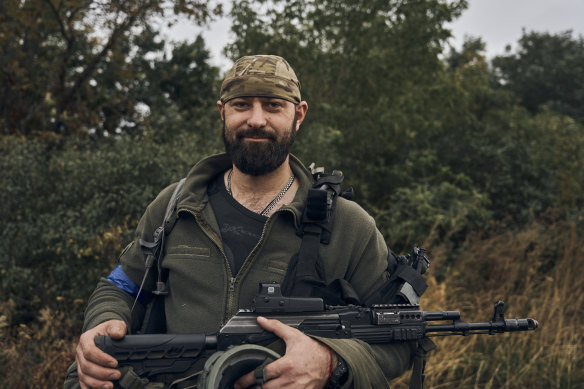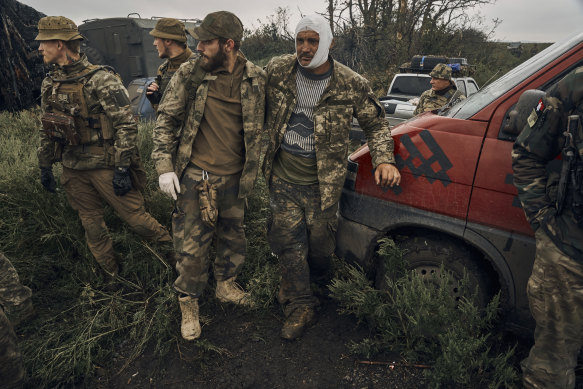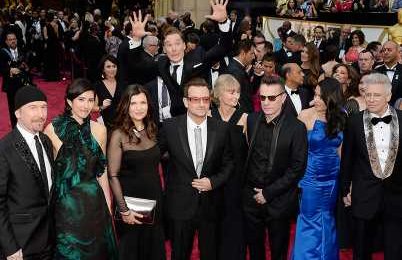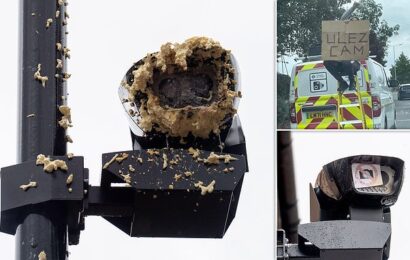Kharkiv, Ukraine: Ukrainian troops expanded their territorial gains on Monday, pushing all the way to the country’s northeastern border in places, and claimed to have captured a record number of Russian soldiers as part of the lightning advance that forced Moscow to make a hasty retreat.
A spokesman for Ukrainian military intelligence said Russian troops were surrendering en masse as “they understand the hopelessness of their situation.” A Ukrainian presidential adviser said there were so many POWs that the country was running out of space to accommodate them.
A Ukrainian soldier smiles in the freed territory in the Kharkiv region, Ukraine.Credit:AP
Ukrainian presidential adviser Oleksiy Arestovich did not specify the number of Russian prisoners but said the POWs would be exchanged for Ukrainian service members held by Moscow. Military intelligence spokesman Andrey Yusov said the captured troops included “significant” numbers of Russian officers.
Ukraine’s deputy interior minister accused fleeing Russian forces of burning official documents and concealing bodies in an attempt to cover up rights violations in the areas they controlled until last week.
Blue-and-yellow Ukrainian flags fluttered over newly liberated towns across a wide swath of reclaimed land. The Ukrainian military said it had freed more than 20 settlements in 24 hours.
After months of little discernible movement on the battlefield, the momentum has lifted Ukrainian morale and provoked rare public criticism of Russian President Vladimir Putin’s war.
A Ukrainian soldier helps a wounded fellow soldier on the road in the freed territory in the Kharkiv region, Ukraine.Credit:AP
“In some areas of the front, our defenders reached the state border with the Russian Federation,” said Oleh Syniehubov, governor of the northeastern Kharkiv region.
The counteroffensive left the Kremlin struggling for a response to its largest military defeat in Ukraine since Russian forces pulled back from areas near Kyiv after a botched attempt to capture the capital early in the invasion.
The Russian Defence Ministry acknowledged the setback in a map that showed its troops pressed back along a narrow patch of land on the border with Russia — a tacit admission of big Ukrainian gains.
Video taken by the Ukrainian military showed soldiers raising the Ukrainian flag over battle-damaged buildings. In one scene, a fighter wiped his boots on a Russian flag on the ground. Other videos showed Ukrainians inspecting the wreckage of Russian military vehicles, including tanks.
In his evening address, Ukrainian President Volodymyr Zelensky said his forces have liberated more than 6000 square kilometres in the east and the south since the beginning of September.
Now Ukrainian teams are disarming land mines and other unexploded weapons in the recaptured areas and searching for any remaining Russian troops, officials said.
It was not yet clear if the Ukrainian blitz could signal a turning point in the war. Momentum has switched back and forth before, but rarely with such a big and sudden swing.
The mood was jubilant across the country.
In Kharkiv, Ukraine’s second-largest city and the capital of the region where the gains have been made, authorities hailed that power and water had been restored to about 80 per cent of the region’s population following Russian attacks on infrastructure that knocked out electricity in many places across Ukraine.
“You are heroes!!!” Kharkiv Mayor Ihor Terekhov wrote on Telegram, referring to crews who restored utilities in Ukraine’s second-biggest city. “Thanks to everyone who did everything possible on this most difficult night for Kharkiv to normalise the life of the city as soon as possible.”
Meanwhile in Russia, signs of disarray emerged as Russian military bloggers and other commentators chastised the Kremlin for failing to mobilise more forces and take stronger action against Ukraine.
Russia has continuously stopped short of calling its invasion a war, instead describing it as a “special military operation” and relying on a limited contingent of volunteers instead of a mass mobilisation that could spur civil discontent and protest.
Ramzan Kadyrov, the Moscow-backed leader of the Russian region of Chechnya, publicly criticised the Russian Defense Ministry for what he called “mistakes” that made the Ukrainian blitz possible.
Even more notable, such criticism seeped onto state-controlled Russian TV.
“People who convinced President Putin that the operation will be fast and effective … these people really set up all of us,” Boris Nadezhdin, a former parliament member, said on a talk show on NTV television. “We’re now at the point where we have to understand that it’s absolutely impossible to defeat Ukraine using these resources and colonial war methods.”
Some in Russia blamed Western weapons and fighters for the losses.
“It’s not Ukraine that attacked Izium, but NATO,” read a headline in the state-supported Komsomolskaya Pravda newspaper, referring to one of the areas where Russia said it has withdrawn troops.
Elsewhere, residents of a Russian village just across the border from Ukraine were evacuated after shelling by Ukrainian troops killed one person, according to Russia’s Tass news agency.
The report cited the head of the local administration in Logachevka, who said Ukrainian troops opened fire at a border checkpoint.
Pro-Kremlin separatists reported that Ukrainian troops were approaching the town of Lyman, a rail hub captured by Russia in late May that offers access to bridges over the nearby Siversky Donets river.
Denis Pushilin, head of the self-proclaimed Donetsk People’s Republic, acknowledged that the situation was “difficult”.
Even amid Ukraine’s ebullience, the casualties kept mounting. Ukraine’s presidential office said Monday that at least four civilians were killed and 11 others wounded in a series of Russian attacks in nine regions of the country. The UN Human Rights Office said last week that 5767 civilians have been killed so far.
Among Monday’s attacks were strikes on residential areas in Kharkiv that killed at least one civilian and set multiple fires, local officials said.
In a reminder of the war’s toll, a council member in Izium accused enemy forces of killing civilians and committing other atrocities. Maksym Strelnikov told reporters Monday in an online briefing that hundreds of people had died during the fighting and after Russia seized the town in March.
Many died from shelling and could not get a proper burial, he said. His claims could not be immediately verified, but similar scenes have played out in other places captured by Russian forces.
The Ukrainian military also claimed to have found more evidence of human rights violations by Russian occupiers. It did not elaborate.
Izium was a major base for Russian forces in the Kharkiv region. The first Ukrainian flag was raised over the city on Saturday, according to Strelnikov. Residents, some wrapped in the country’s flag, greeted Ukrainian forces and offered them food.
Ukraine said the Russians continued shelling Nikopol across the Dnieper River from the Zaporizhzhia power plant, damaging several buildings there and leaving Europe’s largest nuclear facility in a precarious position. The last operational reactor in that plant has been shut down in a bid to prevent a radiation disaster as fighting raged nearby.
The Washington-based Institute for the Study of War said Monday that Kyiv “will likely increasingly dictate the location and nature of the major fighting”.
The British Defence Ministry said the retreat would likely further deteriorate the trust Russian forces have in their commanders and put Moscow’s troops on the back foot.
AP
Get a note directly from our foreign correspondents on what’s making headlines around the world. Sign up for the weekly What in the World newsletter here.
Most Viewed in World
From our partners
Source: Read Full Article









